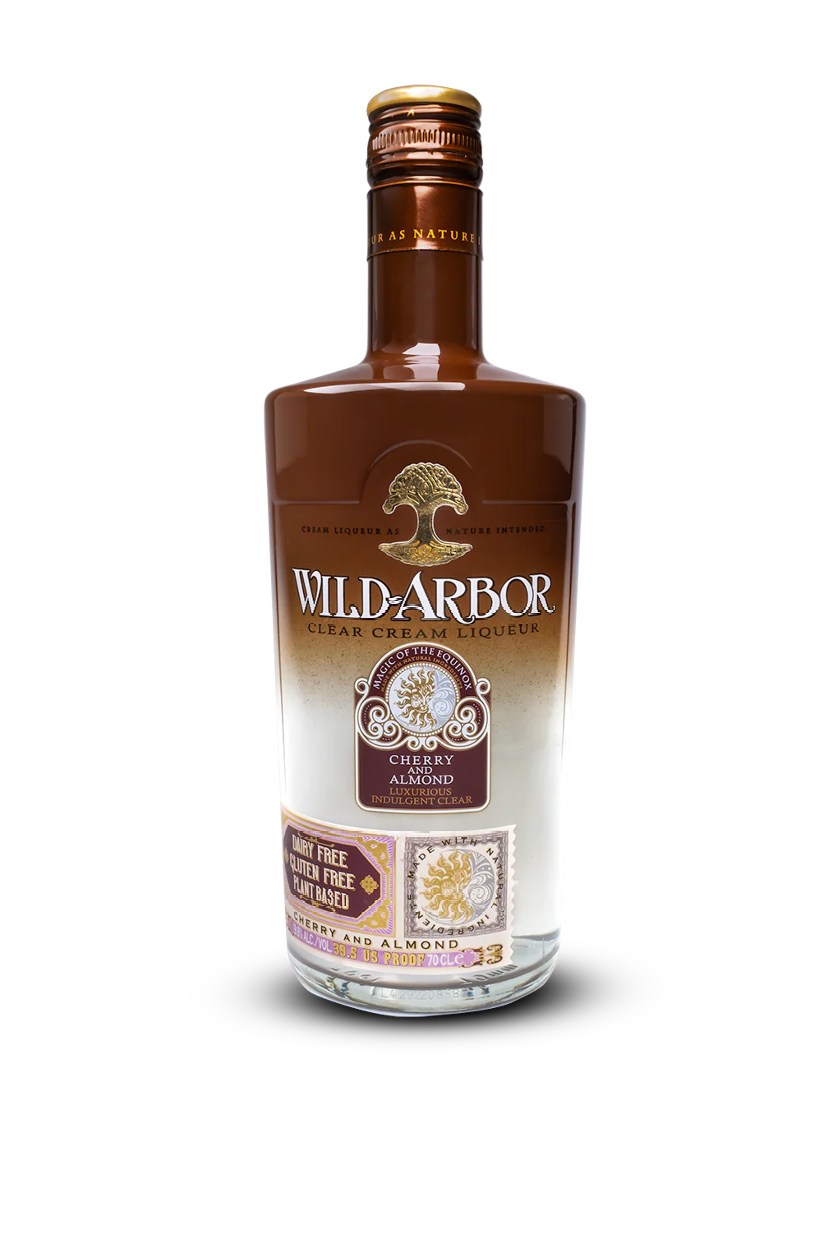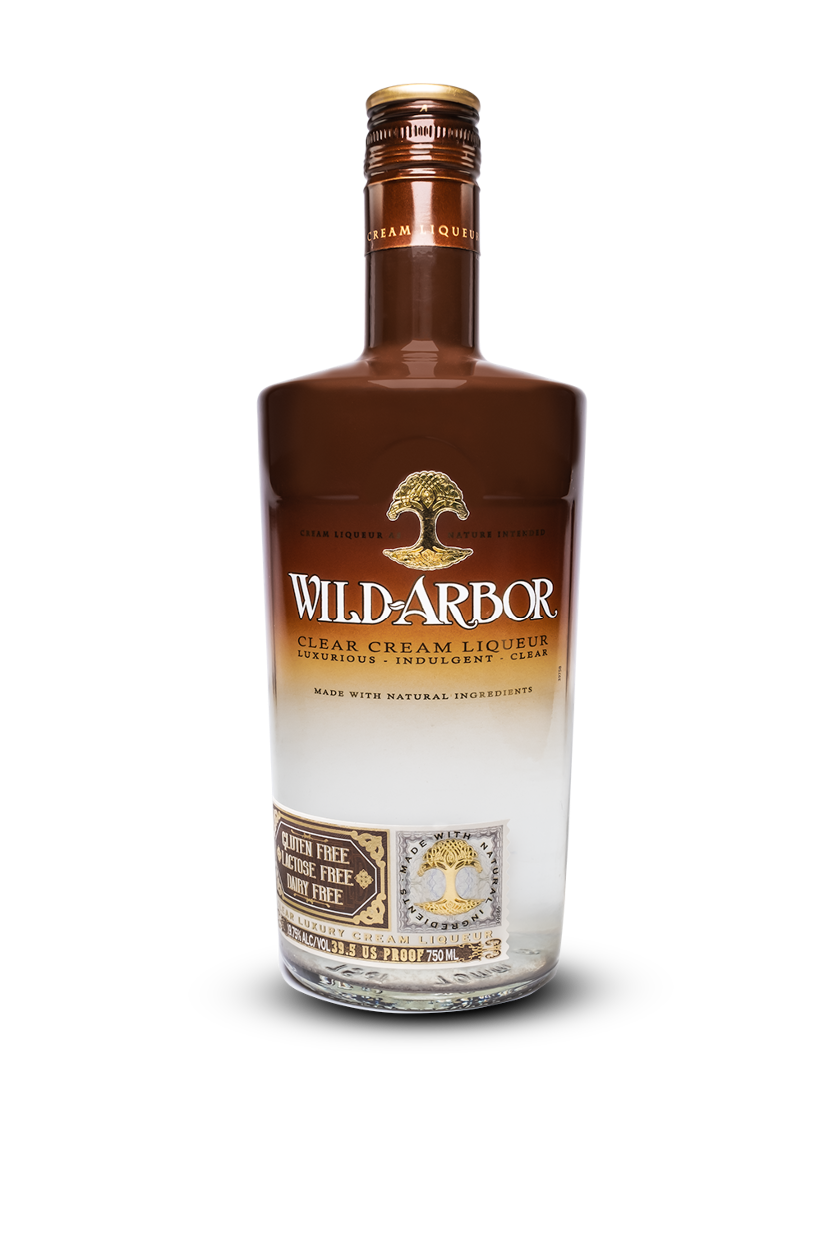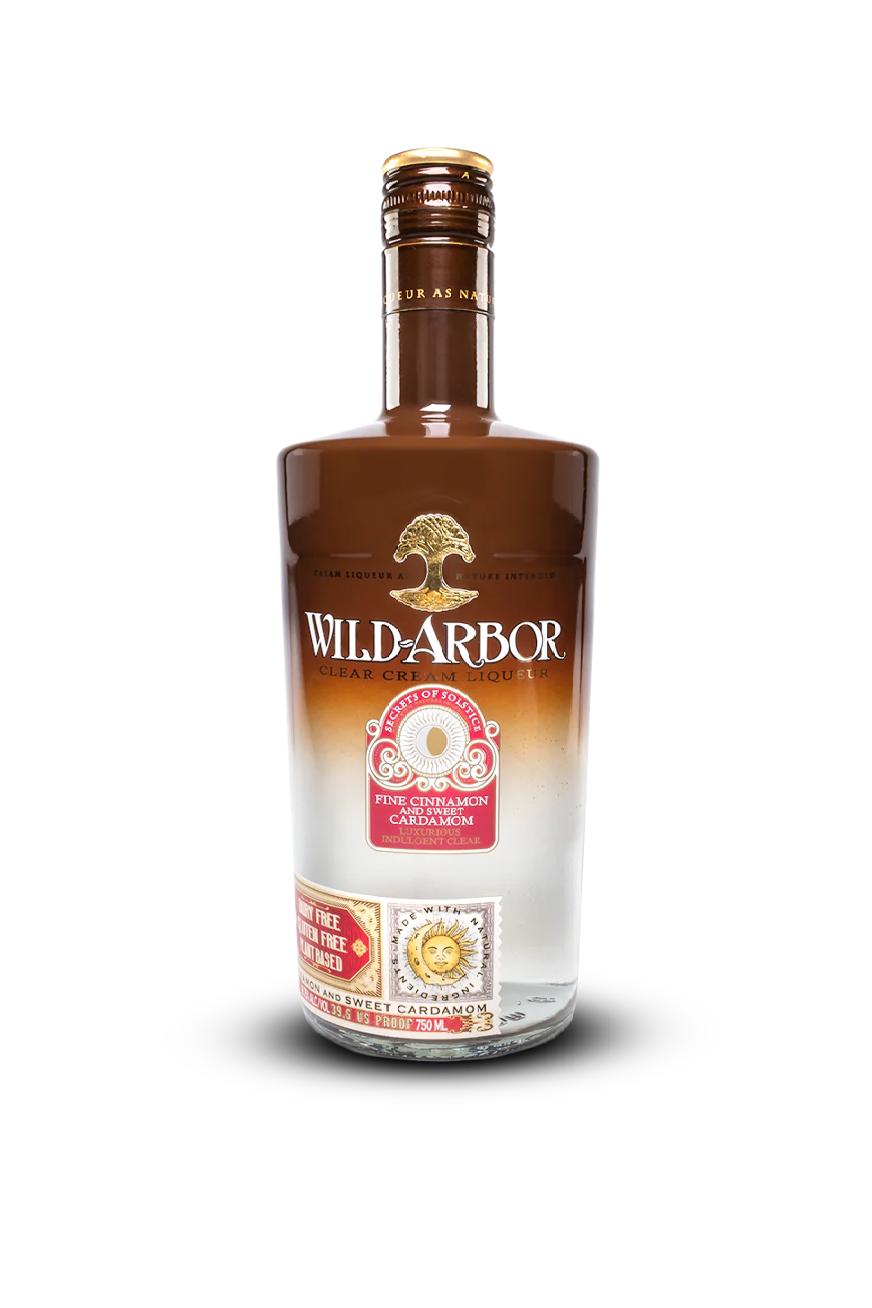FREQUENTLY ASKED QUESTIONS
What do you mean when you say Wild-Arbor is “Plant Based” and made only with natural ingredients?
How come your cream liqueur is clear, when all the others are brown?
Wild-Arbor is clear for several reasons that magically came together. For a start, unlike other cream liqueurs, particularly Irish Cream Liqueurs, sugar cane is used as the alcohol base as opposed to what goes into whiskies. We discovered it was virtually impossible to guarantee that whisky would be totally gluten free. There is much discussion about distillation and whether traces of gluten remain when distilling from a base that has gluten in it. However at this stage there is no cast iron guarantee that traces of gluten from the barley, for example, are not present; hence our choice to go for a guaranteed gluten-free base alcohol.
This change in base alcohol had no effect on taste, and basically gave us a start towards clarity. Then, in our quest to use only plant based products for our ingredients, we found that as a general rule the highest quality and most natural alternatives were also clear.
This led us to another critical decision. We had made a cream liqueur, very similar to other cream liqueurs, smooth and creamy in texture, with a luxurious taste of chocolate, caramel and vanilla. But it was clear. Not at all like other cream liqueurs in appearance. We could do what is very common with cream liqueurs - adding colour back in, often artificial ones. But we liked it clear.
By making a great tasting cream liqueur that was also gluten-free, lactose-free, free of any GMOs or artificial flavourings or colourants, and plant based it also turned out clear. We realised that was something to celebrate, and had a great advantage over other 'brown' cream liqueurs. In one word: Versatility.
Go to our recipes or Instagram to see how you can use Wild-Arbor creatively in a huge range of sophisticated, colourful cocktails and long drinks.
Go to our recipes or Instagram to see how you can use Wild-Arbor creatively in a huge range of sophisticated, colourful cocktails and long drinks.
How many calories does Wild-Arbor contain, is that less than other cream liqueurs?
Can Wild-Arbor be considered a diet cream liqueur?
Well we certainly have not set out to create a diet cream liqueur, as we are all about indulgence and would not recommend Wild-Arbor, with its indulgent sweetness and thickness, if you are on a medically prescribed diet. Having said that, one of the unintended benefits of our recipe, is that traditional cream liqueurs contain 70 – 90% more calories than Wild-Arbor and unlike other cream liqueurs Wild-Arbor is fat free.
For a little extra luxury and indulgence you can always add a little more cream. The beauty with that is you will be using fresh plant-based or dairy cream, we recommend oat-based cream. We have some mouth-watering and delicious recipes this works well with, such as Wild Berries and our take on the Alexander.
Is Wild-Arbor vegan?
How can Wild-Arbor be a cream liqueur without dairy cream and how does it get its creamy mouthfeel?
First of all not all cream is dairy cream. There are many popular cream options out there that are not dairy, and many things are creamy or cream without lactose. We like oat milk, which will froth up like regular milk, cashew milk and half'n'half coconut and almond milk.
In fact, in alcoholic drinks cream traditionally refers to something sweet; such as cream sherry or the various cremes that you can find, and has nothing to do with dairy.
To get the rich velvety creaminess of Wild-Arbor we use gluten-free grains. These grains are boiled gently, then very finely strained to remove the pulp. This process yields a plant-based cream that makes Wild-Arbor so rich and creamy in texture.
Are the ingredients of Wild-Arbor ethically sourced?
Does Wild-Arbor contain any allergens I should be aware of?
The short answer is no. The EU lists 14 food ingredients which must be declared as allergens and the UK still follows this standard. The list of 14 includes the usual suspects such as eggs and peanuts and many more besides including all eight allergens that the US FDA require to be listed. You can find the full EU list here. Wild-Arbor contains none of these 14 and has been issued with the relevant European allergen conformity certificate and statement confirming this. If you are still unsure of whether Wild-Arbor is safe for you to drink, you should seek medical advice.
Hopefully all is good and you can enjoy Wild-Arbor with a truly clear conscience!
Does being plant based and naturally grown mean Wild-Arbor is not processed?
What was the motivation for creating Wild-Arbor?
With Wild-Arbor we simply wanted to create the best possible tasting cream liqueur. At the heart of this product is the fact that we simply love to indulge in its rich, sweet flavour. However, we found that so many of the products available at the time had artificial ingredients that we didn’t want to consume. Or, for that matter, specific ones which some of us can’t consume or choose not to consume based on our own personal beliefs or health choices.
We do not claim to be nutritional or ecological experts. The fact is any strict diet you are on if you are on it to improve your health would tell you to cut out alcohol and sweet things all together. But we think that would make for a rather dull existence. We certainly need to take care of the planet we live on, but isn’t part of life all about enjoying its fruits, even occasionally the naughty ones? So we thought if we are able to, why not create a wonderful, indulgent product that, at the same time, is just that bit better for you and the environment, than the alternatives?
Even among our team at Wild-Arbor, we are a very broad church of carnivores, flexitarians, vegans, dairy and non-dairy consumers. The great thing about Wild-Arbor is that none of us have to compromise, and it gives us the flexibility to choose when to consume, for example, dairy or gluten.
In this endeavour we had a wonderful recipe that had been gifted to us, we like to say by nature. But it still involved some compromises on the ingredients. We then had endless enquiries and requests asking whether it contained artificial ingredients, lactose, gluten and so on. We spent literally a decade listening and refining, changing ingredients and playing back and forth to both meet these requests and improve the flavour. The wonderful thing is, and maybe this is not a coincidence, the better and more natural the replacements we found, the better the taste of Wild-Arbor became.
Where is Wild-Arbor made?
Why do you plant trees?
We have been very fortunate to have stumbled, although with a lot of work and fine tuning, onto a fantastic recipe which we think of as a cream liqueur as nature intended. In addition we wanted to build a business that gave something back. Given our focus on natural ingredients, and the fact that a number of us are close to the outdoors and forestry, it became obvious that working for reforestation to support not just natural carbon capture, but also bio diversity was, well, the natural thing to do.
As such we have pledged to plant a tree for every bottle of Wild-Arbor sold. We planted our first 85 000 trees in North-West Florida in 2020.
Why plant trees in North-West Florida?
It is true that it is not the most deforested area in the world, but that’s sort of the point. We should all be endeavouring to plant wherever and whenever we can. One of our founders had good contacts in the area with the forestry business. This allowed us to create a project we could directly control ourselves, making sure there were no costly middlemen involved. Add to that we liked the idea of actually planting trees somewhere where growth could be substantial and fast to support immediate climate goals.
Although the area does have a lot of trees, there is also a growing human population and, as a result, forested areas are in retreat. In particular, the forestry business there is in decline. This means that it is not very profitable to plant trees anymore. The result being that trees tend to be harvested for a fast return but not replaced.
There are also areas there that have been forests historically, but where the soil is sandy. This further reduces productivity from planting. This was the case where we planted. Because of the sandy ground it would not normally have been commercially planted. This meant it was rapidly in the process of being taken over by low growing shrub. This both retards the growth of healthy indigenous trees and provides poor habitat for wildlife. As such the natural forest would not have returned were it not for our project.
What did you plant and how?
We planted Loblolly pine but did so less densely than a normal commercial plantation.
By doing it this way, we will support and give room for other tree species to naturally regenerate, specifically hardwoods, thereby creating bio diversity. The plan is to support this through forestry management. This means we should get more trees than just the ones we planted over time. It should also become prettier and more natural looking, and more in keeping with the original environment.
Will you ever cut the trees?
Well the honest answer is it depends. It depends on whether it is environmentally and economically beneficial to do so. At various stages of the regrowth of a forest it can be beneficial to “thin” the forest in order to speed up the growth of remaining trees and encourage wildlife. It’s also a little known fact that, from a carbon dioxide absorption perspective, a growing forest is more useful than a fully grown one. Trees die naturally and release large amounts of carbon dioxide as they decompose. Also, if we can sell felled timber our pledge is not just to reforest that area but to invest any profit in further reforestation.
So by being smart, both ecologically and economically, at the same time as we sell more Wild-Arbor, we hope to exponentially support reforestation across the globe.
How does Wild-Arbor impact the environment and climate change?
Unfortunately there are a number of steps in the production and logistics of getting a bottle of liqueur to the consumer that do add to the carbon footprint. Glass making and distillation being two obvious examples. To improve the environment generally, and to mitigate carbon emission specifically, to ensure we capture more carbon than we release, we do four things:
We look at every part of the production and logistics chain to see if we can improve it at reasonable cost whilst not compromising on quality. This is an ongoing process.
-
Using only plant-based ingredients that have at one point grown and absorbed carbon, we restore the natural balance of carbons more than if you use the chemical or animal based substitute ingredients.
-
We look at the total cost of our production process and measure the carbon footprint. Then we invest in carbon emission reducing projects to off-set those emissions. We do this in partnership with the foundation My Climate. This is not ideal, and carbon credits have come under fire. But our view is that, at least for our production, we make sure we take out the same amount of emissions as we generate. Basically we clean up our own mess.
-
We plant our beloved trees. For now we are doing both this and purchasing carbon credits in order to make sure we are by far reducing emission more than we are creating, i.e. Wild-Arbor is net carbon emission reducing. As we evolve our own tree planting projects at ever greater scale, they should on their own be above the level required to off-set the bottle production, but for now we just want to be firmly on the safe side.
A CREAM LIQUEUR FOR EVERY SEASON



